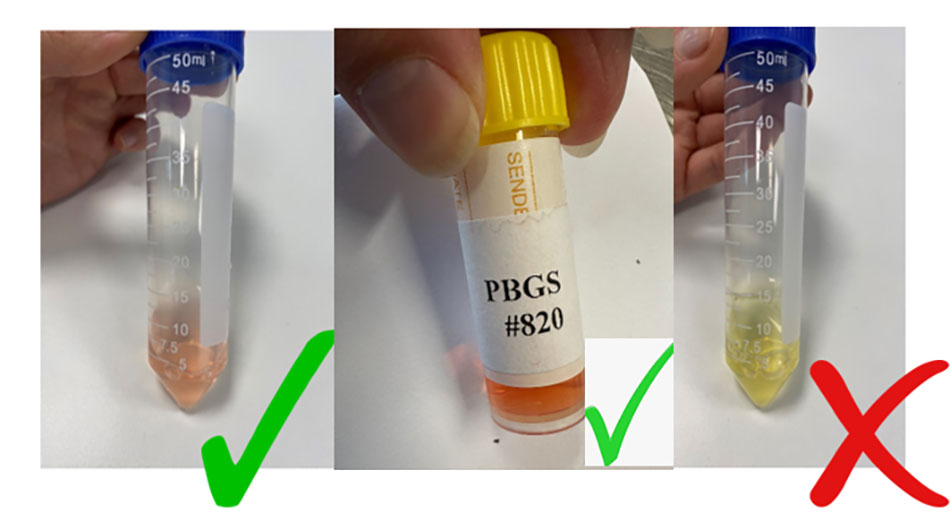Last updated 13 March 2025
Introduction
Australian import conditions require testing of horses for equine influenza virus in quarantine. A validated pan-reactive polymerase chain reaction (PCR) assay targeting the matrix gene for influenza A virus is used. This document outlines the sampling materials and technique for obtaining the nasopharyngeal swabs (NPS) from horses (or nasal swabs from foals under 6 months of age) during the post-arrival quarantine period at the Mickleham Post-Entry Quarantine facility and horse Approved Arrangement sites.
This document is provided for information only. To the extent that this document is inconsistent with any import permit or direction, the terms and conditions of the import permit or direction take precedence and will apply. Failure to comply with a condition of an import permit, direction, industry notice or authorisation to enter a quarantine facility may constitute an offence.
Sampling materials
Viral Transport Media (VTM) storage vials: Any size freezable vial may be used, noting that freezing VTM in 50ml vials may increase risk of wastage due to discolouration on thawing.
NPS: 16-20” (8” for foals under 6 months of age) sterile swab with polypropylene stick and large cotton head (not guarded uterine swabs).
Sample collection vials: 50ml vial.
Media: For samples sent to Elizabeth Macarthur Agricultural Institute (EMAI), VTM for NPS must be phosphate buffered gelatin saline (PBGS). For samples sent to the Australian Centre for Disease Preparedness (ACDP), ACDP’s VTM or PBGS from EMAI may be used. 8ml of the relevant VTM should be used per sample collection vial.
Important notes on Viral Transport Media
- Ensure strict compliance with the expiry date of VTM (if kept frozen, the expiry date is 6 months from preparation).
- VTM for NPS can be defrosted at room temperature or in the fridge for 2–24 hours. VTM must not be rapidly thawed before use.
- Thawed VTM can be stored in the fridge for:
- up to two weeks where sourced from ACDP, or
- up to four weeks where sourced from the EMAI.
It must be either used or discarded by this time.
- Thawed VTM can be decanted into a larger (50ml) sample collection vial to accommodate the NPS swab if it had been stored in a smaller vial. The total amount of VTM per sample collection vial should be approximately 8ml.
Note: Slight differences in VTM volume (i.e. 7ml or 9ml) will not affect sample integrity. - VTM is UV-sensitive and must be stored away from light.
- When frozen, VTM will be yellow in colour and will change to pink (ACDP) or orange (EMAI) once thawed (see images below).
Note: If thawed VTM discolours to red, purple or yellow, it must not be used (see image below).
Procedure for collecting samples
Please follow this procedure for collecting NPS samples:
- Prepare a 50ml collection vial containing 8ml of VTM to hold the sample.
Optional: if VTM was stored in a smaller vial, it can be decanted into the 50ml vial at this point, provided care is taken to minimise contamination risk during transfer. - Remove the NPS (or nasal swab) from its packaging.
Optional: you may dip the NPS in saline solution at this point. Please note where EMAI is the testing laboratory, their preference is to use a dry swab. - Collect the sample ensuring the NPS reaches all the way to the nasopharynx (or into the ventral nostril, avoiding the false nostril, for nasal swabs for foals under 6 months old).
- Place the tip of the NPS (or nasal swab) in the 50ml collection vial and cut the swab to the appropriate length to fit into the vial.
- Ensure the NPS tip is submerged in the VTM at the base of the collection vial.
- Ensure that the collection vial is closed tightly and is appropriately labelled. At a minimum, this must include the animal’s name/identification and the date collected.
- Ensure the collection vial containing the NPS (or nasal swab) is stored appropriately until submission.

